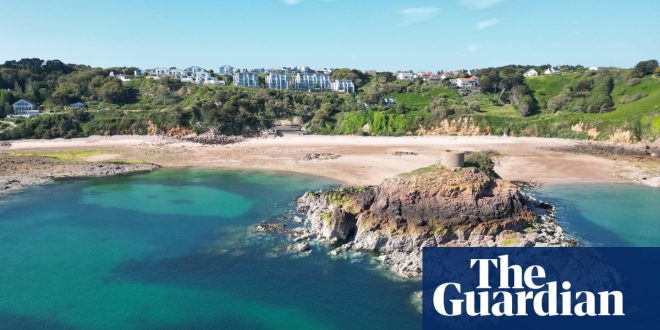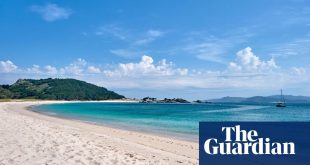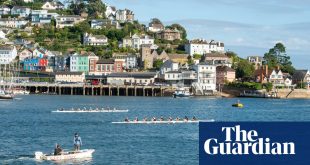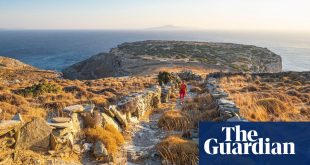The steps down from the clifftop were many and steep, but Portelet Bay, on Jersey’s south coast, was worth each one. The tide was out and a tentacle of rose-gold sand sliced the beach into two smooth curves, leashing tiny Ile au Guerdain to the land – for now; soon the leviathan tide would turn, making this tower-topped mound an island again.
I stuck a tentative toe into the water and squealed. The water’s sparkle belied the fact this was the brisk Channel and not, as it appeared, the Aegean. But I plunged in anyway, and surfaced just as – out of nowhere – the Red Arrows swooped by.
I had deliberated long and hard over which beach to visit on my last day in Jersey, before taking a ferry on to Guernsey. I was happy with my choice. In fact, I was happy with all my choices. It was early summer and I had fancied that most summery of trips – island-hopping. But I didn’t want to travel too far. So, rather than jetting to far-flung parts, I caught ferries around the Channel Islands instead, hoping for a similar castaway feel without the flying, but still with a smidgen of “foreign”. Closer to France than England, the bailiwicks of Jersey and Guernsey have a Gallic air, with placenames derived from Norman French.
My adventure began in Portsmouth, from where the Commodore Clipper slowly chugs to Jersey. There are faster boats but this overnight sailing seemed the most efficient: board for dinner and dock by breakfast, ready to explore. Using a mix of coastal-path walks, hire bikes and the buses that fan out from capital St Helier meant no car was required.
Over my four-day stay, I focused on Jersey’s edges, which are variously sandy, dreamy, dramatic, history-laden and superbly strange. They are also protected. In 2011, after a groundswell of protest against insensitive developments, Jersey national park was formed, encompassing most of the island’s coast. It covers, for example, the entire three-mile length of westerly St Ouen’s Bay, where I sat on the German-built sea wall – one of many remnants of the island’s second world war occupation – watching surfers ride the waves.
It includes east coast Archirondel, where I scoffed seafood caught by the owners of the lovely Driftwood Cafe. And it includes Plémont, in the far north-west, where a mistimed visit meant I found arguably the island’s most beautiful bay devoured by the waves. Take note: Jersey’s shore is a movable feast. The island has one of the world’s largest tidal ranges: when the tide is at its lowest, the island can almost double in size; at its highest, some beaches vanish altogether.
That wasn’t the case when, on my penultimate day, I visited La Rocque, in the far south-east. It was low tide and Trudie Hairon-Trox of Jersey Walk Adventures led me across the newly exposed seabed.
“It’s a fascinating landscape, never quite the same,” she said, as we splished through the vast moonscape of rock pools, runnels, boulders and kelp. “It might look like a wasteland, but the biodiversity is huge.”
We headed for the oyster beds of the Jersey Oyster Company, where Trudie explained the boom, bust and 1970s revival of the industry, and the hard labour that goes into growing these prized molluscs. After our blustery stroll, we settled into the nearby Seymour Pub, to chew – “Don’t swallow!” – the supremely local spoils: refined, salty, cucumber-fresh.
After that last swim, it was time to hop onward. From St Helier, it took only an hour to sail to Guernsey, the second-largest Channel Island. And the best? “You must say Guernsey’s better!” insisted two sisters I met on my first evening; we were all getting tipsy on a tour of Rocquette Cider farm, tucked deep in the island’s midriff. “Jersey is so la-di-da!” the women laughed, moving on to the berry gin. “It’s just slower here.”
Jersey hadn’t exactly felt full-throttle. How much more laid-back could Guernsey be? To investigate, I hired an ebike. It’s the ideal way to get around this three miles-by-six miles island. Making forays from my hotel at Grand Havre Bay, I kept getting lost in the spaghetti of ruettes tranquilles (quiet lanes) that squiggle via steep contours, high hedges and sign-less junctions. But if you take it as an adventure, and don’t worry where you end up, it’s a lovely way to get around.
It was in this fashion that I found myself, whether on purpose or not, at Petit Bot, a pretty pebble bay at the end of a deep crotch of green, where I parked my bike beside an old loophole tower – one of 15 built around the island in the late 18th century to guard against French attack. It’s how I ended up at Le Gouffre, admiring both the formidable sea cliffs and the cafe’s crab sandwiches. And it’s how I got to L’Erée, where I basked in sunshine below a huge concrete Dalek, part of the largest German army gun battery built on the Channel Islands. From here, I gazed wistfully to Lihou – alas, the quarter-mile-long causeway to this teeny isle was cut off by the tide.
Lihou remained off-limits throughout my stay, but I had more success hopping to Sark. It’s an hour’s ferry ride from Guernsey’s capital St Peter Port, but several centuries back in time. The island, just three miles square, was made a feudal state in 1565 and remained that way until 2008; the hereditary seigneur still plays a prominent role and retains sole rights to such things as flotsam, jetsam and the keeping of doves. Cars are banned, with only tractors, horse-drawn carriages and bicycles allowed. I hired a bike to explore.
It was a jolly escapade from a bygone age. Helmet-less and carefree, I pedalled down empty dirt tracks, following a map so simple a child might have scribbled it. I abandoned the bike at will, leaving it leaning on fences while I strolled wild clifftops, waded through paths thick with daisies, dipped down to secret coves and searched out ancient dolmens, abandoned mines and redundant canons – surely all plot points from a Famous Five adventure? I even drank lashings of fresh milk from Sark Dairy Trust’s self-serve machine.
The wind was angry, frothing the sea and tossing the gulls. It wasn’t really beach-lazing weather, but my top pick was Derrible Bay. Like all of Sark’s beaches it’s a bit of a trek to get there, and I found it consumed by high tide. But I sat happily on a ledge above, watching the waves fizz around the rocks and lick at the sea caves.
There are several places to stay on Sark, but I headed back to Guernsey, in order to make my final hop before sailing homeward: to tiny, perfect Herm, where even bicycles aren’t permitted. With each new island my world had shrunk. Now, after a 20-minute ferry ride, I was on a scrap of land barely bigger than Hyde Park, where the only entertainment was provided by Mother Nature.
It was a beautiful day. The wind subdued, the sea outrageously flirtatious: look at me, it seemed to coo, in a smooth, come-hither drawl; look how I ripple and sashay, how prettily I glitter. Nowhere was this more the case than at Shell beach, which I reached via the coast path, passing Puffin Bay (sadly, I didn’t see any) and almost irresistible Belvoir Bay. But then I saw Shell beach luxuriating ahead of me: a creamy-white spread curving around the dunes and seeping into shallows so clear I could see each sunken stone, each frond of kelp.
On the beach, I stripped to my cossie and crunched over the crushed-shell sand. The tide was low; it took ages to wade into water deep enough to swim. When I finally did, the chill nipped again – ah yes, still the Channel – but it wasn’t so bad. I’d come to the Channel Islands as a quicker, greener alternative to more desirable far-flung places but now floating in this joyous turquoise, I found there wasn’t anywhere I’d rather be.
The trip was provided by Visit Jersey, Visit Guernsey and Condor Ferries. A UK-Jersey-Guernsey-UK sailing costs from £100pp with standard seating or £211/£346 for one/two in a two-berth cabin. Guernsey-Sark day returns from £28, Guernsey-Herm day returns from £17. Jersey Walk Adventures runs various seabed walks from £24pp. Ebike hire available from Lakeys Jersey and Go Guernsey. Jersey’s Somerville hotel has doubles from £84 room-only. Guernsey’s Peninsula hotel has doubles from £127 B&B
 Top Naija News – Nigeria News, Nigerian News & Top Stories Top Naija News – Nigerian Newspapers, Nigerian News. topnaijanews is a daily Nigerian newspaper covering Latest News, Breaking News, Entertainment, Sports, Lifestyle and Politics.
Top Naija News – Nigeria News, Nigerian News & Top Stories Top Naija News – Nigerian Newspapers, Nigerian News. topnaijanews is a daily Nigerian newspaper covering Latest News, Breaking News, Entertainment, Sports, Lifestyle and Politics.




